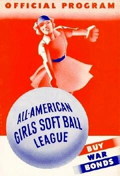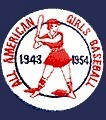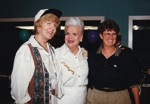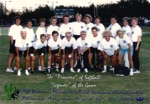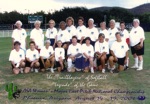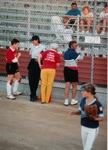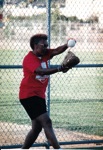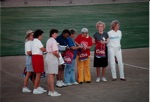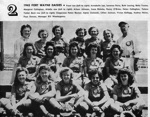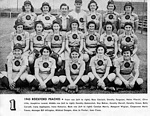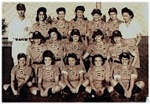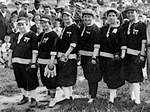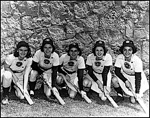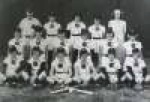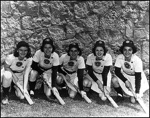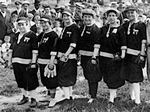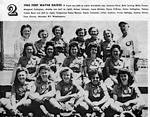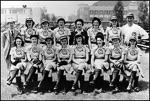
Old Time
Legends & Old Timers
History
Ken Sells, the AAGPBL's first president, is a robust, 83-year-old retiree living in Paradise Valley, Arizona, not far from where several major-league baseball teams stage their spring training. He maintains that although female baseball players enjoyed themselves and made reasonably good money, they had a serious mission to accomplish. "They proved," he says, "that women didn't have to sacrifice their femininity to be standouts in what was then a man's world."
That's one of the things Philip K. Wrigley had in mind when he decided to start up a women's league in 1942. The chewing-gum magnate and owner of the Chicago Cubs baseball team was afraid the wartime draft might shut down the major leagues altogether; a number of minor-league teams had already been forced to suspend operations. If the big leagues did fold, Wrigley reasoned, it might be possible to transfer a professional women's league into those parks. But the major leagues got through the war years intact and consequently the AAGPBL remained in a number of smaller Midwestern towns and cities, where factory workers had money to spend but couldn't travel much because of gas rationing.
In the early 1940's amateur softball leagues for women were thriving in thousands of communities all over the country. Wrigley decided to skim the best players off those teams, whittle the candidates down to a select few, and then use that reservoir of talent to set up his new play-for-pay league.
Wrigley contributed the major share of the start-up costs and also footed half the operating expenses of each team (Local supporters in the four charter cities - Rockford, Illinois; Racine and Kenosha, Wisconsin; and South Bend, Indiana - guaranteed the other half.) As a savvy baseball man and shrewd entrepreneur, he knew what he wanted and he understood how to go about getting it. He drew upon the Cubs organization for executive talent and scouts, and he persuaded his friend Branch Rickey, the respected general manager of the Brooklyn Dodgers ( and later the Pittsburgh Pirates) to serve as an advisor and trustee.
Wrigley also understood the importance of image. His league would have nothing to do with the kind of short-haired, mannishly dressed toughies then touring the country on several all-girl barnstorming teams. As one of Wrigley's associates put it, the new league's athletes would be expected to epitomize "the highest ideals of womanhood." The order went down to Ken Sells, the Cubs' assistant general manager and head of the AAGPBL: at the league tryouts in Chicago that spring, Mr. Wrigley expected to see nothing but healthy, wholesome, "All-American" girls.
In May 1943, more than a hundred of the best female softball players in North America registered at the Belmont Hotel in Chicago, and then assembled for tryouts and spring training at the Cubs' Wrigley Field. Most of them were underage, overawed, homesick and as green as the outfield grass. Jane (Jeep) Stoll, presently a resident of Phoenix, went to Chicago as a recent high school graduate from rural Pennsylvania. "I had never ridden on a train," she says "I sat up all night in a Pullman car because I didn't understand how that seat was gonna be my bed."
Sophie Kurys was 17 when she showed up in Chicago, a taciturn Polish Ukrainian from Flint, Michigan. "It was raining when I got there. I told them I wanted to turn around and go right back home. They moved me in with some older girls, and probably told them to mother me a bit. The next day the sun was shining and I felt fine."
Girls. It was always "girls," never "women," and in their recollections it remains so today.
Oh my, what nice eyes you have
The players soon found that they were in for more then they had bargained for. After getting up at dawn and working out all day, they were required to attend charm school in the evening. The classes were conducted by representatives of the Helena Rubinstein cosmetics company, who taught the athletes how to put on makeup, get in and out of a car, and put on a coat with seemly grace. The girls also learned how to enunciate correctly and how to charm a date (look right at him and say: "Oh my, what nice eyes you have"). To avoid getting dirt under their fingernails when sliding on the base paths, they were told to scratch a bar of soap before the game.
Charm school fit right in with the league's so-called femininity concept. It produced a lot of good publicity but it was also a big pain in the neck, or knee, or calf. "It wasn't easy to walk around in high heels with a book on your head when you had a charley horse," remembers Lavonne
(Pepper) Paire Davis, who played shortstop and catcher for three teams and is now enjoying retirement in Van Nuys, California.
At the end of that first training camp, Wrigley's four managers selected the 60 best players and divided them up, as equally as possible, into four teams. Then it was time to "play ball." The players were paid between $65 and $125 a week. The 108-game "split" season lasted for three months with the winner of the first half playing the winner of the second half in a championship series at the end.
The slugger who became a nun
That premiere season had barely gotten under way before a new generation and gender of baseball personalities began to shine. One of them was a statuesque redhead named Ann Harnett. She hit the ball well enough to finish as one of the league's best batters in 1943. Eventually the charismatic slugger became a nun and coached a boys' team at a Catholic school. One day, a former AAGPBL executive recalls a nun dropped by and asked, "How're the boys upstairs?" She was referring, or course, to Wrigley and his associates.
For a decade, the AAGPBL teams - each consisting of 15 players, a manager, a chaperone and a driver - rattled around the heartland, trailblazing a path of equal opportunity where no women's professional sport had ever gone before. Everywhere they went, they won new fans - and kept them. "Maybe at first the men came out to see the legs," says Pepper Paire Davis. "But they stuck around when they realized they were seeing a darn good brand of baseball."
For managers, the league reached into the ranks of old-time ballplayers, many of whom came and went trailing faded dreams of glory. Bill Wambsganss of the Cleveland Indians, the only man ever to pull off an unassisted triple play in the World Series, always carried around a Yellowed press clipping to prove it. Others, like the famous Red Sox slugger Jimmie Foxx, preserved their cherished memories in a bottle.
Chaperones protected the morals of the players at home as well as on the road. The girls were officially forbidden to drink, gamble, violate curfew, wear shorts or slacks in public, or go out on dates alone without permission and an interview of the prospective swain. A good thing, too. "My mother wouldn't let me play until I convinced her we'd be chaperoned," remembers Betty (Moe) Trezza of Brooklyn.
Quite a few of the girls were underage and the league kept a particularly close eye on them. Thelma (Tiby) Eisen, who was an outfielder with three different teams between 1944 and 1952, had an admirer when she was a rookie who followed her on a road trip. He checked into the same hotel one night and invited her up to his room before they went to dinner. "I wasn't there three minutes before there was a knock at the door," Eisen says. "It was the house detective wanting to know what was going on."
Some chaperones knew their baseball; others did not. We had one who was famous for yelling things like, 'Hit a home run, honey, and we win!' Sophie Kurys recalls. "The only trouble was, we would be four runs behind in the bottom of the ninth with two out and the bases empty." Some chaperones had other priorities. Shirley Jameson of Albuquerque remembers going to bat
in a tense situation only to be restrained by her chaperone. "Oh, my dear," the woman exclaimed. "You don't have your lipstick on!"
Off the field, chaperones sometimes had their work cut out for them. Maddy English, a third baseman for the Racine Belles who now lives in Everett, Massachusetts, once told a sportswriter who wouldn't stop pestering her: "If you don't leave me alone, I'm going to jump in Lake Michigan." He didn't. She did, and had to be fished out. Other infatuations were less threatening. Sophie Kurys had a fan club of 11- and 12-year-old boys in Racine, one of whom invited her home for a pork chop dinner one afternoon before a game. Faye Dancer, an exuberant center fielder for the Fort Wayne Daisies who now resides in Santa Monica, California, got a letter from a GI in France after her picture appeared in Life magazine. "I am not proposing," he wrote, "but I have about $1,000 and old jalopy in New Jersey, I am footloose and fancy free, and I can settle anyplace."
P. K. Wrigley, a member of one of Chicago's most prominent families, was the ultimate businessman. He had inherited the Wrigley chewing gum empire from his father and, like his father, had used shrewd advertising to increase the family fortune. With the gum came the Chicago Cubs. The Cubs themselves were a disaster, frequently ending the major-league season at the bottom of the National League. They often left Wrigley tied in knots. He tried everything to make them a winning team. He was known to change the Cubs head coach every couple of months. One season he even hired a man who supposedly could put an "evil hex" on opposing teams.(6)
However, 1943 presented a different problem. During the 1930's, the Great Depression had caused attendance to plummet, despite record-setting performances by baseball greats such as Joe DiMaggio and Ted Williams(7). As the nation entered the war, Wrigley knew that attendance would keep falling. He also realized that players would be drafted to fight. Wrigley knew that the quality of baseball would drop when the best players went overseas. The public wouldn't go to baseball games if they were poorly played. The lack of money and the lack of good talent threatened to shut down the major leagues. Wrigley did not want to see money go to waste. He needed something to fill the ballparks if the major leagues folded. His solution to the problem was a women's professional softball league(8).
In 1943, softball was the most popular sport in America and women were active participants in the game. Wrigley knew there was something about women playing ball which could be an unbelievable money-maker, if everything was done right. Wrigley's original idea was to create a professional women's league, drawing his ballplayers from the vast number of women's amateur softball leagues across the country(9). But for his league to be successful, he had to change the public's image of women ball players. Women softball players often had reputations equal to that of prostitutes. Traveling teams were known as "Bloomer Girls," and played under team names such as "Slapsie Maxie's Curvaceous Cuties."(10) Wrigley knew that in order for the League to be successful, the ballplayers had to be portrayed as ideal "All-Americans." It required shrewd advertising, which happened to be what Wrigley did best.
He began by assembling his management team. Ken Sells, an employee of the Cubs, was named the president of the League. Branch Rickey, the well-known general manager of the Brooklyn
Dodgers, became an advisor and trustee. Bill Veeck offered his support after the League started. Arthur Meyerhoff became heavily involved in the League as head of the advertising program(11).
Wrigley's next step was to find ballparks in which to put the teams. His original idea was to play the teams in major-league ballparks on off-dates, but black-out regulations, the absence of lights at Wrigley Field and ballparks that were already over-booked caused him to reconsider his initial scheme. He decided to put the teams in mid-sized war production cities throughout the Midwest. In the eventuality that the major leagues did fold, he could then move the teams into major league parks(12). Wrigley began to search for cities for the teams to play in. In proposing the idea to the leaders of potential cities, Wrigley told them, "We will select the kind of players that people will want to see in action. Then we will groom them, to make sure they are acceptable. It won't be like the old days of peep shows and Bloomer Girls...The League will be good for you and your community, good for the war effort, and good for you."(13) He aimed at making the League a patriotic undertaking. The League, based in Chicago, would start up all of the franchises in the cities. If each city were to raise $22,500, Wrigley would match that sum out of his own pocket. Players would sign with the League, and be assigned to a team. The next year, if the player were to sign again with the League, they would go back into a selection pool and be reassigned to one of the teams. The League would be non-profit. Any money made would go to fund projects in the respective cities(14).
Four cities responded positively to Wrigley's call, and the first four teams were born. They were the South Bend, Indiana, Blue Sox; the Rockford, Illinois, Peaches; the Racine, Wisconsin, Belles and the Kenosha, Wisconsin, Comets(15). Eventually, there would be as many as ten teams in the League at a time(16). The cities were eager to support Wrigley's League, which would showcase a hybrid of softball and baseball. Wrigley had concluded that softball was too slow, and he was afraid the fans would quickly lose interest. A Rules Committee had determined the basic rules of the game, but Wrigley tinkered with the rules to speed the game up(17). The underhand softball pitch would still be used, but the pitching distance would be forty-three feet and the basepaths would be seventy feet, measurements approximately halfway between that of a softball and baseball diamond. The number of players was cut from ten to nine and the games would be nine innings instead of softball's seven. Runners could lead off base and the ball was slightly smaller than a regulation softball(18). It was now time to find the players.
Wrigley sent his scouts all over the country and into Canada. Advertisements in the newspapers told the time and place of regional tryouts. The scouts were instructed to search for feminine women who were good players(19). Seventy-five players selected from the regional tryouts came to Chicago in May of 1943 for the final tryouts at Wrigley Field(20). Mary "Bonnie" Baker remembers that "It was very cold and ugly and windy at the tryouts, but I loved it anyway."(21) All of the girls loved it. They were being offered a chance to get paid for something they loved to do. The salaries themselves were unbelievable. The League offered salaries ranging from $55-$150 a week. At the time, the average salary was $40 a week(22). Everyone at the tryouts saw the League as a fantasy that they would have the opportunity to live. The fantasy was especially vivid for a young girl named Dorothy "Dottie" Schroeder. "I was fourteen years old and had been raised on a small farm. (The try-outs) were very awe-inspiring, and they kept us busy. We stayed at the Belmont Hotel not far from Wrigley Field. My mother came up for a few days and stayed with some friends. After a few days she went home. I was very homesick. She said, 'Well, you can come home with me, and everything will be all right, or you can stay.' I wanted to play ball so bad I stayed. The other players took me under their wing and mothered me, and I got over the homesickness. I liked playing ball so much I just wanted to play. I was so young that the thought never crossed my mind that I wouldn't make the League."(23)
Bonnie Baker and Dottie Schroeder were two of the players to make the final cut of sixty players. They were very excited about getting the chance to play baseball, but they were about to find out that Wrigley was going to give them more than they bargained for. Wrigley, as he had advertised to potential backers, was intent on making the players into ideal All-American girls. His aim was to give the League a patriotic image. He had insisted that the League wouldn't take a cent of the profits made at the turnstiles(24). He sought out middle-sized cities that had war industries. In days of gas rationing, the people of these cities would be able to go to their home-town games easily(25). The League would serve as entertainment for the hard working, a chance to relax and watch America's favorite pastime, with an undeniable twist. The girls would truly be All-American ideals.
The public's first impression of the girls was crucial. Much thought went into the design of the uniforms. The final pattern was ultimately designed by Mrs. Wrigley and a famous poster artist by the name of Otis Shepard, who was responsible for most of Wrigley's billboards(26), but the emphasis on femininity was all Wrigley. The uniforms were somewhat like belted tunics, with skirts that flared to the knee but could easily be hemmed. They were short-sleeved, and buttoned up the front on the left side so that there would be room for a circular team logo on the chest. They wore elastic shorts underneath the skirts, and socks that were rolled to just below the knee. The hats were normal baseball caps fitted to the women's sizes(27). Although they were feminine, the uniforms were a bit impractical. Dottie Schroeder remembers that they were "... almost like a ballerina skirt. The pitchers would do the windmill wind-ups and the skirts would get in the way. It took some getting used to but as the years went on we would pin them and they got a lot shorter."(28) The main problem with the skirts was that when the girls would slide, they would often get nasty abrasions called "strawberries." But, as Bonnie Baker knew, "The strawberries came with the territory."(29)
Wrigley then concerned himself with the girls' demeanor. During spring training the girls would work out all day and then attend Charm School at night. The classes were taught by representatives of the Helena Rubenstein cosmetics company. Helena Rubenstein was the feminine ideal of the time, and Wrigley used Charm School as another publicity stunt to give the girls a positive image. At Charm School, the girls were taught everything from how to put on make-up to how to charm a date(30). Former first baseman Dorothy "Kammy Kamenshek remembers that "We had fun with it. If you have to do it, enjoy it."(31) For some of the girls, Charm School was very helpful. Many had grown up on farms and weren't familiar with feminine style and grace(32). But most knew that it was another one of Wrigley's publicity gimmicks.
In order to insure that the players acted like ladies on and off the field, Wrigley instituted a set of "Rules of Conduct" for the players. The girls were not allowed to smoke or drink, wear slacks or shorts in public, etc. If they broke any of the rules, they were fined. If they did anything "inappropriate" on or off the field, they were fined(33). Wrigley wanted the image of the players to be squeaky clean. The players either had to have shoulder-length hair or short hair in curls, and they were to never go without make-up(34). "They were selling a product." said second baseman Sophie Kurys. "They wanted us to be feminine and (at the same time) play like Joe DiMaggio. What they didn't realize was how well the girls could actually play."(35)
To add to the clean All-American image, Wrigley hired chaperones. Chaperones had a difficult job. They were mothers, nurses, communicators, etc. They had to do everything from keeping track of the equipment and the uniforms to making sure the girls were in by curfew(36). Dorothy Hunter was a player the first season of the League. When she refused a contract to play ball, she was sent a contract to be a chaperone. "I said, 'Twenty-eight's a little old to be playing baseball.' They sent me a contract, saying that I had a good disposition to be a chaperone. I went and tried it. I was a little hesitant at first because when I had played ball the gals were snotty to the chaperone, but I liked it and stayed until the end (of the League)."(37)
Getting along with the girls required a lot of stamina, especially since they were always playing pranks. Pepper Paire Davis remembers one prank in particular that she and the Grand Rapids Chicks played on chaperone Dorothy Hunter. "Dottie was a great gal, with a fiery temper. But she was deathly afraid of fish. So, one morning, I went fishing with the guys, and caught some perch. We knew her routine after each game. She would take care of everything, and then she would take a bubble bath. As she was about to get into the tub, one of the girls called her up from their room and said they had a charley horse. So Dottie put on her robe and went to take care of the fake charley horse. Meanwhile, I slipped into the bathroom and put the perch into the tub. She came back and got ready to get into the tub. Meanwhile, all fifteen of us on the team were waiting out in the hall. All of a sudden we heard a scream and she came running out into the hall all wet, with no towel, robe, or anything. Since I was the only one that fished, I was fined the $25. That was a lot of money in those days!"(38)
Encounters with such practical jokes tended to be just part of the job for a chaperone. Some chaperones could handle it. Others couldn't. Amazingly enough, not all of the chaperones knew very much about baseball. Sophie Kurys remembers that "We had one who was famous for yelling things like, 'Hit a home run, honey, and we win!' The only trouble was, we would be four runs behind in the bottom of the ninth with two out and the bases empty."(39) But for the most part, they were able to handle the tough job assigned to them of caring for fifteen girls and sometimes the managers as well. "They were a good group of gals." says Dottie Hunter of her Grand Rapids Chicks. "I enjoyed what I did."(40)
Wrigley had everything he wanted to portray the players as All-American girls. The publicity almost seemed to come naturally. Newspapers and national magazines were ultimately drawn to this "novelty" that, as one magazine said, was another one of "Millionaire Philip Knight Wrigley's radical ideas."(41) There was, of course, skeptism in the beginning. "At first, (the fans) came out of curiosity. But when they saw how good we were, they were hooked,"(42) recalls Dottie Schroeder. In truth, as the popularity of the game grew, the publicity became more widespread. People all over the country were reading about "the Queens of Swat" and "the Belles of the Ball Game"(43) and marveling at this Midwestern ballgame.
The game itself evolved over time. Starting as a cross between softball and baseball, it soon evolved to be "baseball, plus or minus a few feet."(44) The League was originally called the All-American Girls Softball League, but as the League evolved, so did the name. In 1944, it became the All-American Girls Ball League and in 1945, the All-American Girls Professional Baseball League(45). The ball size dropped dramatically, from a twelve inch circumference at the beginning of the League to nine by the last season, the size of a regulation baseball. Pitching styles went from underarm to sidearm and, in 1948, they began to pitch overhand. At the
League's end the pitching distance was sixty feet, the same as in regulation baseball, and the basepaths were eighty-five feet, five feet short of the ninety-foot regulation(46).
The managers throughout the League were often baseball legends. However, being a major-league star didn't always mean success as a coach. Besides the usual problems a baseball manager dealt with, he had to cope with husbands coming home from the war and wanting their wives at home, as well as what to do when a player became pregnant. One pitcher, Dottie Collins of the Ft. Wayne Daisies, pitched until she was five months pregnant(47). Managers also faced the risk of losing their job. Towns wanted winning teams, and if the team faltered, the managers were the first to go(48). Some were successful, however. Max Carey, formerly of the Brooklyn Dodgers, coached the Milwaukee Chicks to the championship in their first year in the League. He later went on to become the League President from 1945 to1950(49). Another success story was Bill Allington. In the eight years that he coached the Rockford Peaches, they won four championships(50). It was a tough job and, as one manager grumbled, "This is the only place where you can't go into your own lockeroom."(51)
The summer of 1943 was a good first season for the League. Wrigley decided to try and do what he had originally planned: put the teams in major league ballparks. His experiments were the Minneapolis Millerettes and the Milwaukee Chicks. Minneapolis was an immediate failure, mostly because it was too far away from the rest of the teams. The local franchise was folded by Wrigley within a month, and the team spent the rest of the season on the road. The next year it was adopted by Ft. Wayne, became known as the Daisies, and eventually was one of the top teams in the League(52).
The 1946 championship was a battle that is said to have been one of the highlights of the League, climaxing with a game that Commissioner Max Carey called, "The best game I've ever seen, barring none."(65) In the 1946 championship series, the Racine Belles were up three games to two in a best of seven series against the Rockford Peaches(66). Pepper Paire Davis remembers that "In the second game, I was going for a pop fly and slipped and sprained my ankle. For the rest of the series, they would freeze my ankle before every game and then tape it. At one point I hit a triple and fell down about ten times running around the bases."(67)
The final game was a baseball classic. Carolyn Morris of the Peaches was pitching a no-hitter, but was taken out in the 10th inning. Joanne Winter, pitcher for the Belles, was surviving by the skin of her teeth(68). "There had been three or four squeeze plays," recalls Sophie Kurys, "and one ball went over our leftfielder's head, but she ran and caught it, and saved us from a home run."(69) The game remained scoreless until the 14th inning. Millie Deegan was pitching for the Peaches. She was a former outfielder who was less adept at holding people on base(70). Kurys, who would later become the League's all-time base stealer, remembers that in the final inning they managed to take advantage of that fact. "I got a single and then stole second. Betty Trezza was up and she hit a line drive to right field. I headed for home and the girl threw a strike to home plate, but I slide away from the tag, and we won the game. Everybody came running out onto the field and threw me up into the air. It was very exciting."(71)
Article courtesy of Arleene Johnson Noga.
The 1946 Shaughnessy Playoffs: excerpt from the 1947 Official Year Books,
author unknown but the article appeared in many of the team year books in 1947
For the second successive year, the league champion also copped the Shaughnessy play-off crown, when the Racine Belles, duplicating the feat of the 1945 champion Rockford Peaches, went all the way in the post-season series to win double laurels. The Shaughnessy play-off series of 1946 proved a fitting climax to a thrill-packed season in the All-American and brought forth a great display of heroic pitching, fielding and hitting feats on the part of the participating teams and players.
The Racine Belles touched off their slam-bang season by defeating the South Bend Blue Sox three games to one and then taking the Rockford Peaches four games to two. The first series game for Racine was a seventeen-inning thriller with the Sox which they won 3-2 and the last and clinching game was a sixteen inning hair-raiser won by the Belles from the Peaches by a 1-0 score.
The fourth place Peaches reached the final round by virtue of their tight three game to two victory over the second place Grand Rapids Chicks, in a series which was featured by some scintillating pitching performances. Connie Wisniewski, the league's ace pitcher, made a Herculean effort to pull the Chicks through after they had suffered two straight losses in their home park to start the series. Wisniewski appeared in four of the five games played in the series. She won one of the Grand Rapids victories and saved the other in a relief role but finally succumbed in the final game before the opposing slants of Rockford's Millie Deegan, who tabbed two of the Peaches wins and held Grand Rapids to three safe blows in the finale. Carolyn Morris, series heroine of 1945, appeared in three games for the Peaches, winning one and losing one.
In the upper bracket, Racine was relying on the pitching of Anna May Hutchison and Joanne Winter, with the former going all the way in the opening seventeen-inning affair against Jean Faut of South Bend. The fates favored the Belles in this series when, on two occasions, play-off games' progress were called because of rain with the Blue Sox leading in both games at the time. After the Blue Sox had trampled the Belles to even the series in the second game behind the superb pitching of Betty Luna, it was all Belles the rest of the way. Hutchison repeated in the third game with a fancy two-hitter and Joanne Winter held the hard hitting Sox to three singles in the finale.
When the Belles and the Peaches met in the final best-four-out-of-seven set, it was ding-dong pitching all the way. Millie Deegan, erstwhile star second sacker, who had turned to pitching in the late weeks of the regular season, proved to be the real thorn in the side of the Belles, and had Carolyn Morris, the Rockford ace, enjoyed the same pitching fortune, the Peaches might well have repeated their 1945 triumph. The Belles hopped off to a two-game lead by taking the opener easily enough and then snatching the second contest out of the fire with a ninth inning rally to win 2-1. Morris had held the Belles to one single in eight innings and Deegan was rushed to the rescue too late to save the game in the ninth. Jo Winter of the Belles, meanwhile, held the Peaches to three safe blows in the game.
With the teams switching operations to Rockford, Deegan came back to win a great 2-1 pitching duel with Hutchison, each pitcher allowing only three hits. Winter, back in her best form, put the Belles two games up again with a two-hitter on the following night, to win 4-1 against Morris. But Deegan again kept Rockford hopes alive by taking the measure of Hutchison and the Belles 1-0, with each team getting five hits.
The final game was played in Racine with Winter and Morris as mound opponents. Winter was in hot water continually and the base paths were constantly clogged with Peaches, as the Rockford team garnered 13 hits with never a runner denting the platter and left 19 base runners stranded. Meanwhile, Morris was pitching the masterpiece of them all and at the conclusion of nine innings, there had not been a safe blow by Racine. The Belles broke the ice in the tenth and brought about the removal of Morris in favor of Deegan but they did not score until the sixteenth inning, when Sophie Kurys led with a single, stole second and scored on a terrific sliding play at the plate on a short single by Betty Trezza to bring the 1946 season to a fitting climax.
Millie Deegan was the pitching star of the over-all series, beating Grand Rapids and Racine twice each and winning four straight before the Belles finally stopped her in her final game relief role. Jo Winter shone on the mound for the Racine Belles, winning one from South Bend and three from Rockford for a final accounting of 4 wins and 1 loss. Sophie Kurys of the Belles would be adjudged the all-round star of the series, leading all the players of the series in hitting and scoring runs and playing a stellar game afield. In the South Bend series she scored six runs and garnered nine hits in four games and in the final game against Rockford, she was the entire Racine offensive, stealing five bases and scoring the only run of the contest after her own hit and steal.
Dorothy "Snookie" Harrell of the Peaches was a lively hitting star in series games and helped to keep the Peaches spark alive in their final efforts against the Belles. Dottie Kamenshek, the league's batting champion for 1946, was held down fairly well by Racine's pitching until the final game when she rapped out four hits. Maddy English, Racine third sacker, was an important hitter in the South Bend series, winning the all-important first game with a double in the seventeenth inning. Connie Wisniewski, Grand Rapids pitcher, and Edythe Perlick, Racine left fielder, both hit circuit blows in series games as did English. Betty Whiting of Grand Rapids did some fancy extra-base socking to help keep the Chicks in the series against Rockford.
In ten series games, Racine had a total of 36 runs, 66 hits and 20 errors; in eleven games Rockford had 17 runs, 69 hits and 18 errors; in five games Grand Rapids had 8 runs, 27 hits and 10 errors; in four games South Bend totaled 18 runs, 25 hits and 12 errors.
© 2005 AAGPBL Players Association, Inc. All Rights Reserved.
Article courtesy of Arleene Johnson Noga.
1946 All-Star Team : excerpt from the Official 1947 Team Year Book,
author unknown but the article appeared in many of the team year books in 1947
For the first time in the four-year history of the All-American Girls Baseball League, we present an official All-Star team which has been selected as a result of the combined vote of all eight managers who were active in the league in 1946.
It should be borne in mind by the fan that the All-Star players presented in these pages have been selected on the basis of their achievements and performances in the 1946 season only.
In the voting of the managers, as many as fifty-three different players received recognition, which gives an indication of the diversified difference of opinion, even among managers, when it comes to judging a player's merits and worth. However, all of those selected on this 1946 All-Star aggregation gained a clear-cut margin in total points to leave no question as to their qualifications to represent the best in ability among All-American girls of 1946.
Perhaps every fan has his or her own idea as to what an all-star team should be but we do not think that many can argue that the players named herein would not give as good an account of themselves as any other group of girl ball players in the world.
A pitching staff which comprises Connie Wisniewski, the leader in won and lost percentage for the third year in a row, and Joanne Winter, who shared a new record for games won in one season with Connie at 33, in addition to breaking or tying several other league records in 1946, might be sufficient. Add to this the extremely capable Carolyn Morris, the league's ace no-hit pitcher, and Anna May Hutchison, who set several league records and pitched more low hit games than any pitcher in the league in 1946, and you have the cream of the pitching crop on the bases of last season's play.
When it comes to the infield, you need look no further than Dottie Kamenshek at first base, where she reigned supreme in all-round play, being the league batting champion of 1946 and setting a new all-time record for total hits. Nor can you dispute the right of Sophie Kurys to second base, where she won player of the Year honors on the basis of her stellar 1946 performance in which she set new all-time records for stolen bases, for bases on balls, for runs scored, for runs in one game and for fielding percentage at second base.
At shortstop, where Senaida (Shoo Shoo) Wirth won the distinction of being the only rookie to make the all-star grade, and at third base, where four-year veteran Maddy English got the nod, the competition was much tighter. But both of these players took laurels on the basis of their all-round play, fielding, throwing, defensive fire and offensive ability.
Of the outfield births, the candidates were legion. Merle (Pat) Keagle who led all the league's outfielders in hitting and who ranked extremely high in the extra base and runs-batted-in department, could not be denied a place on the basis of her all-round effective and aggressive play. Elizabeth (Lib) Mahon was another who sparkled in 1946. In addition to batting in the top brackets, Lib set a new all-time record for runs-batted-in, sure-fire evidence of hitting in the clutch. And she led the entire league in the important Total Advanced Bases column, the
supreme test of a player's ability to hit when it counts. Third spot in the outfield went to deserving Tiby Eisen, who is one of the speed merchants of the league, a ball hawk in the field, a much better than average hitter and on the basis of her 1946 play, in which she virtually carried first year Peoria Red Wings on her capable shoulders, she deserved an all-star post.
The catching assignment was a race between Mary (Bonnie) Baker of the Blue Sox and Ruth Lessing of the Chicks. Baker enjoyed her best of four seasons with the stick and won the nod on the basis of her fine batting. Lessing shone as a great receiver and holds every all-time record for catchers.
The championship Racine Belles took four all-star selections with pitchers Winter and Hutchison, second baseman Kurys and third baseman English. South Bend Blue Sox came through with three all-stars in the persons of catcher Baker, shortstop Wirth and outfielder Mahon. Grand Rapids Chicks also showed with three stars in pitcher Connie Wisinewski, outfielder Keagle and catcher Lessing. Rockford Peaches made two highly important contributions in the remaining post with outfielder Eisen and pitcher Morris.
And so, hail to the All-Stars of 1946. We are privileged to do fitting honor to those players who have won the right to a position on this mythical team on the basis of their performance, their skill, their sportsmanship and their value to their respective teams in 1946.
